Study about breeding status, population, national distribution, and habitat use by satellite tracking were conducted for the first time, for the conservation of endangered Black-faced Spoonbills in the Republic of Korea. Max. 3,327 birds were observed by the simultaneous monitoring on September, 2020 from 20 main sites including 7 sites of Incheon in Korea. The population was estimated about 3,861 birds by max. counts on each site in Republic of Korea. Approximately 5,000 birds were assumed including the population using on Democratic People’s Republic of Korea after breeding from Republic of Korea. About 65% of them were observed from Incheon city and Gyunggi province, and approximately 98% were inhabited along western coast of Korea. Main habitats were Yeonggwang, South Ganghwa, Yeongjong-do, Hwaseong wetland, and Yubu-do. More than 700 birds were only observed from Yeonggwang which was the most concentrated area. Annual survival ratio was estimated about 80% according to re-sights of color bands, but the survival ratio of juveniles would be lower. Black-faced Spoonbills has used on habitat nearby after the breeding, but some of them has moved to far away. And Black-faced Spoonbills have used mainly on tidal flats, but they have also used on diverse habitats such as reservoir, reclaimed area, channel, abandoned salt pan, and agricultural land. The migration has started from mid-October to late-November, and the distance was shortly from 400 km far to 4,000 km. The pattern of migration was divided into 2 groups, which one group has directly flown to China across Yellow Sea, and other group has flown along west coast of Korea, then moved to China, or Japan. Some of them showed irregular flyway just like wandering. The main threats for Black-faed Spoonbills were predators, accidental collision, fishing lines, and development of the coast. Steady efforts for conservation of the habitat were needed such as designating for protected area, stopping coastal development and reclamation. Civil co-operation by public awareness would be important for conservation of the habitat.
This report was organized by the EAAFP Secretariat and produced with the support of Incheon City as one of the cooperative projects following the conclusion of the MOU for the conservation of Black-faced Spoonbills between Incheon and Hong Kong. The participants were over 41 person from Waterbird Network Korea, National Institute of Ecology Endangered Species Restoration Center, National Institute of Biological Resources, Incheon Black-faced Spoonbill Network, Ecological Education Hub Mulsae Al, Ganghwa Bird Watching Club, Yeongjong Environmental Union, Saemangeum Citizen Monitoring Group, Friends of Wetlands and Birds, Jeju Wildlife Research Center, Eco Horizon Institute, Green Korea Incheon, KFEM Incheon, etc.
Table 1. Number of individuals from National Black-faced Spoonbill monitoring from August to October
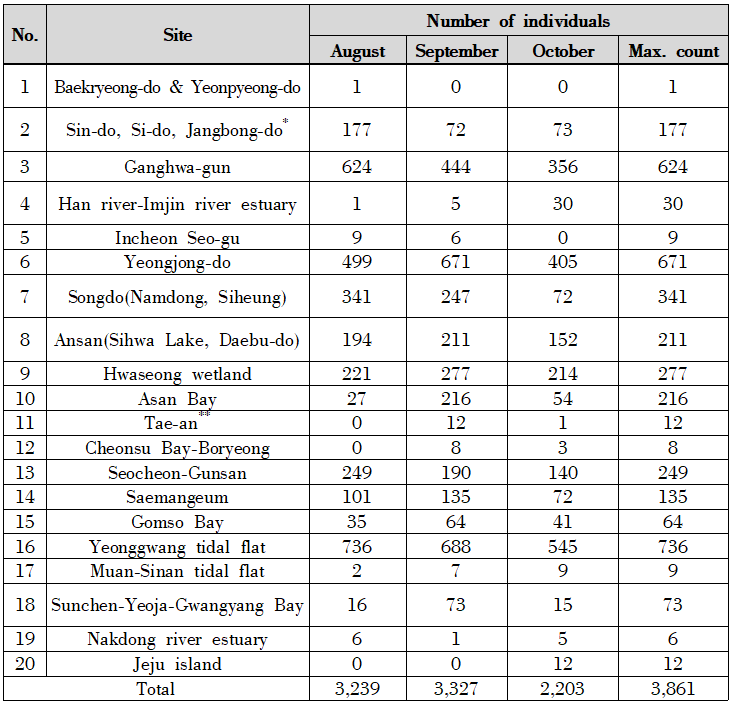
| Aug-2020 | Sep-2020 | Oct-2020 |
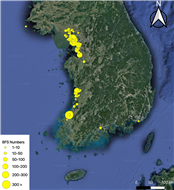 |
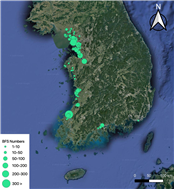 |
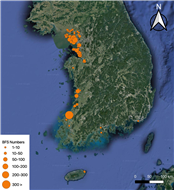 |
Table 2. Sum of re-sights of color bands attached from Korea in 2020 year.
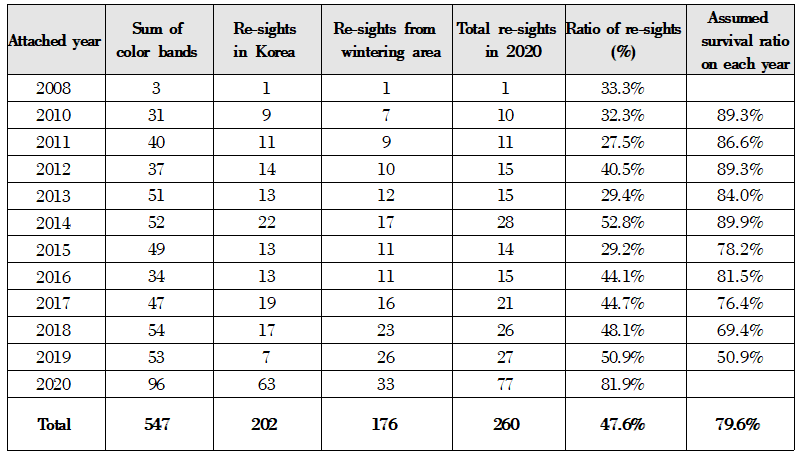
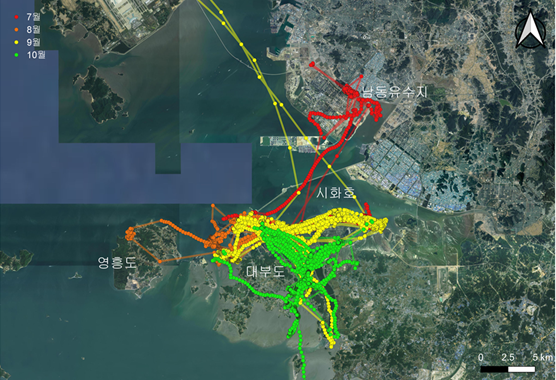
Figure 2. Habitat use of color band Y59 after fledged from Namdong reservoir.
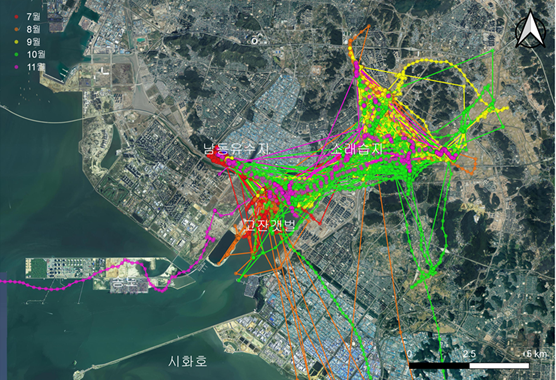
Figure 3. Habitat use of color band Y70 after fledged from Namdong reservoir.
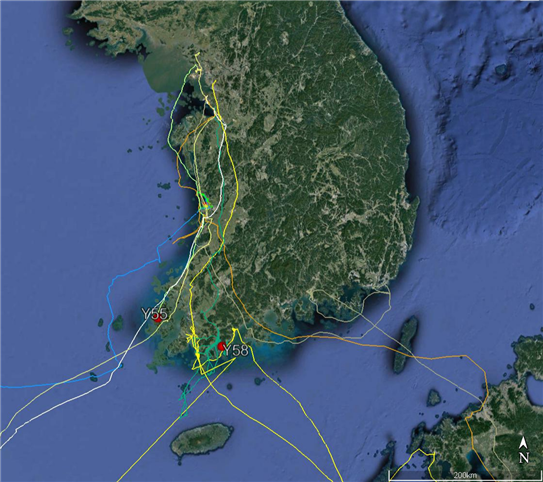
Figure 4. Migration routes of 8 Black-faced Spoonbills passing through west coast of Korea followed by satellite tracking devices.
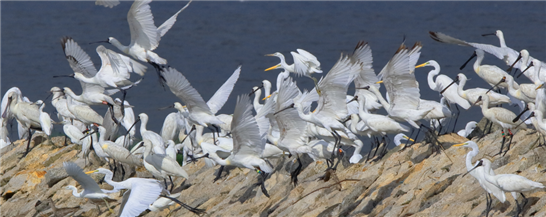
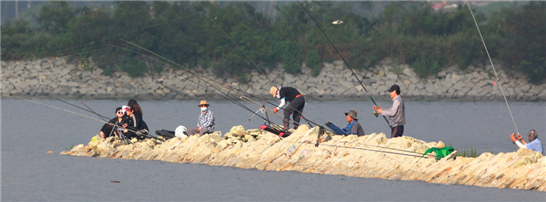
Figure 5. Disturbance by fishing on the stone embankment which is the roosting site of Black-faced Spoonbills at high tide.
2020년 저어새 전국 모니터링과 서식지 이용 연구 관련 기사
2020년, 멸종위기종 저어새를 보호하기 위해 국내 처음으로 저어새 번식 상황과 개체수 파악, 전국 분포, 이동 추적에 의한 저어새 서식지 연구 등을 동시에 진행하였다. 인천 7개소를 포함하여 전국에 20여개 주요 지점에 대한 저어새 동시 모니터링을 통해 9월에최대 3,327개체를 관찰하였다. 지역별 최대수를 고려하여 남한의 서식 집단을 약 3,861개체로 추정하였다. 북한을 서식지로 이용하는 개체를 고려하면 남북한에 서식하는 저어새 수는 약 5,000개체일 것으로 판단하였다. 인천광역시를 포함한 인천・경기 일대에 저어새의 약 65%가 관찰되었으며 서해안에만 약 98%가 서식하였다. 핵심 서식지는 영광, 강화 남단, 영종도, 송도, 화성습지, 유부도 일대 등이었다. 이중 영광에서만 700여개체가 확인되어 가장 많았다. 저어새의 유색 가락지 확인을 통해 연간 생존률이 약 80%로 추정되었으나 어린 개체는 생존률이 상대적으로 낮은 것으로 평가되었다. 저어새는 번식 후에 인근 서식지를 주로 이용하나 일부는 멀리 이동하는 경향을 보였다. 또한 저어새는 갯벌뿐만이 아니라 유수지, 간척지, 물골, 폐염전, 농경지 등의 다양한 서식지를 이용함이 확인되었다. 저어새는 10월 중순부터 11월말까지 이주를 하였으며 개체에 따라 짧게는 400km에서 멀게는 4,000km가 넘는 먼거리를 이동하기도 하였다. 이주 경향은 크게 2부류로 서해를 건너 곧바로 중국으로 이동하는 개체들과 한국의 서해안을 따라 이동하다가 중국과 일본으로 이주하는 개체들로 구별되었다. 일부는 이주 방향이 일정하지 못하여 방황하는 듯한 경로를 보였다. 저어새의 서식과 이주에 미치는 위협 요인은 포식자, 충돌 사고, 낚시줄, 해안 개발 등으로 파악되었다. 저어새 서식지에 대한 꾸준한 보호 노력에 필요하며 보호지역 지정과 해안 개발, 매립 등의 제한 노력이 요구되었다. 또한, 저어새 서식지에 대한 시민 인식 증진을 통한 보호 협력 등이 중요하였다.
본 연구는 인천과 홍콩의 저어새 보전을 위한 MOU 체결에 따른 협력사업의 하나로 EAAFP 사무국이 주관하고 인천시의 후원으로 제작되었습니다. 참가자는 41명 이상이었으며 한국물새네트워크, 국립생태원 멸종위기종복원센터, 국립생물자원관, 인천저어새네트워크, 생태교육허브물새알, 강화탐조클럽, 영종환경연합, 새만금시민모니터링단, 습지와새들의친구 제주야생동물연구센터, 생태지평, 인천녹색연합, 인천환경운동엽합 등이었습니다.
original documents can be found here:
EAAFP BFS WG link: Black-faced Spoonbill Working Group




